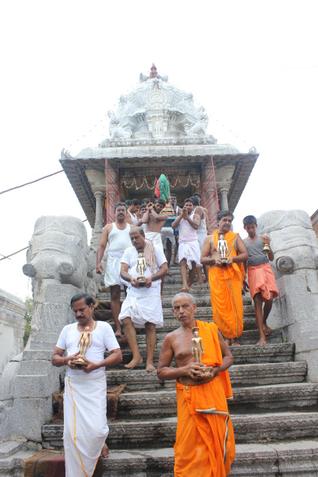
Published: December 28, 2013 17:56 IST by "The Hindu" Newspaper | Updated: December 28, 2013 20:08 IST
Tamil Jain?
Mahima Jain

Tamill Jains at a festival in Mel Sithamoor, a Tamil Jain village, near Tindivanam. Photo: Mahima Jain A forgotten community talks of its past.
Parsvanath is a Tamil Jain from Vandavasi, Tamil Nadu. He teaches at a school in Bangalore and many people, including his colleagues, often ask him “How come you are a Jain? You are not Marwari; you are a south Indian. When did you convert?”
Because a majority of the Jains are from Rajasthan and Gujarat, people think that all Jains are from there, says Parsvanath.
His identity is questioned for two reasons: a) he doesn’t ‘look it’; b) his peers have never heard the term ‘Tamil Jain’. ‘How could one be a Tamil and a Jain?’ they wonder. Many have forgotten the long history of Jainism in Tamil Nadu and the contributions of Jains to Tamil history.
The marginalisation today of Tamil Jains — or ‘Samanars’ as they were once known — is in stark contrast to their position and numbers in first millennium AD. Jainism reached Tamil Nadu in around 300 BC and flourished here, with indigenous Tamils followers. The Tamil Jains shaped the religion, politics, culture and society of the Tamil region, with three of the five major Tamil epics (Silapaddikaram, Civaka Cintamani, and Valayapathi) written by Jain authors. They were also instrumental in organising the first Dravida Sangam in 470 AD, believed in a casteless society, emphasised on education for all and gave great respect to women religious teachers. The Tamil Jains were omnipresent in the first millennium AD but now hardly anyone knows them.
According to Parsvanath, the reason for his community’s obscurity is that it is a smaller and endogamous community within the already small 0.4 per cent Jain population in India. They are also mostly scattered in rural Tamil Nadu and hail from farming families, with little or no presence in the public sphere. “The countryside is bad. The agricultural lands lie fallow. Dwindling population and migration from villages is a big problem,” says K. Ajithadoss, a Tamil Jain and botany professor in Chennai.
Contrast the near invisibility of Tamil Jains to the well-known North Indian Jain community in Tamil Nadu. They too are a small population, although outnumbering the Tamil Jains, but are prominent merchants and businessmen. They run schools and colleges, engage in philanthropy and have built several temples. “In Chennai alone, there are about 100 temples built by the North Indian Jains,” says Rajendra Prasad, another Tamil Jain. In comparison, Chennai has only 18 Tamil Jain temples catering to roughly 1,500 Tamil families.
Temples matter. They are the most visible public spaces and identity markers. The difference between the two Jain communities is quite visible in the temple architecture, with the north Indian faction worshipping in marble temples while the Tamil sect mostly has Dravidian-style stone temples — bound by faith but separated by culture.
Jayarajan, a Tamil Jain school teacher, has another explanation for the identity crisis. “Our community has been struggling for a livelihood for the last 30-40 years,” he says. “In such situations, you won’t have much individuality.”
There’s more to the marginalisation of the Tamil Jains than just economics. Scholars of religious studies and historians explain that the seeds of this partial amnesia date back to the religious conflict between the Jains and the Saivites circa 700 AD. Popular narrative went on to cement the idea that Jains don’t belong to Tamil culture when, in fact, they have been a part of it for more than 1500 years. On the ‘othering’ process over the centuries, Religious Studies professor Indira Peterson writes that the idea of Jainism not being part of genuine Tamil culture is a construct fashioned vigorously in the Pallava era and consolidated during the Chola period, saying the celebration of Saiva saints, hymns, and narratives was patronised by Chola kings as a strategy of hegemony.
The project of marginalisation appears to have succeeded. Tamil Jains are referred to only in the past tense. This de-linking of Jainism from the pluralistic Tamil culture, which has otherwise accepted various religions into its fold, has left the Tamil Jains caught between their religious identity as ‘Jains’ and their cultural identity as ‘Tamils.’
mhmajain@gmail.com